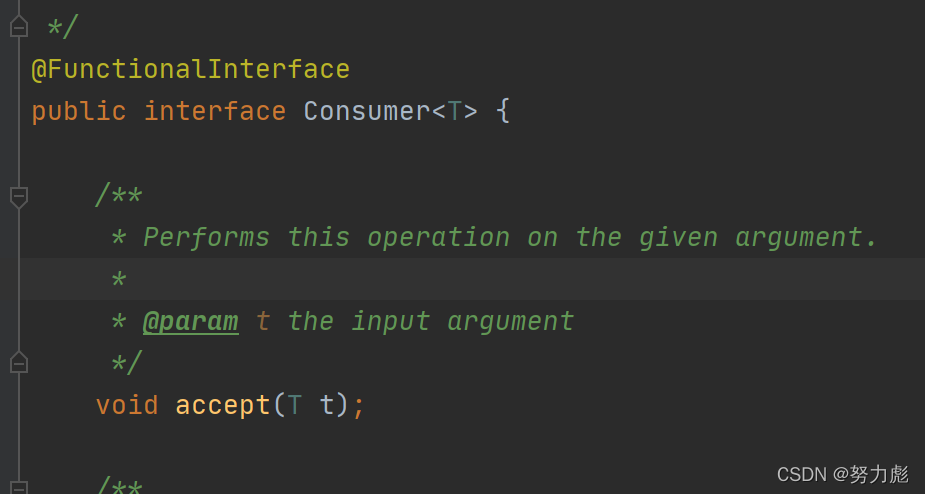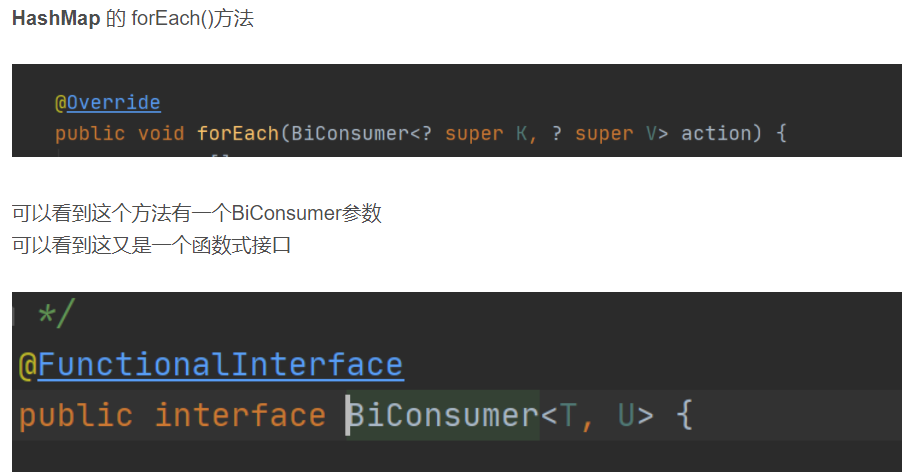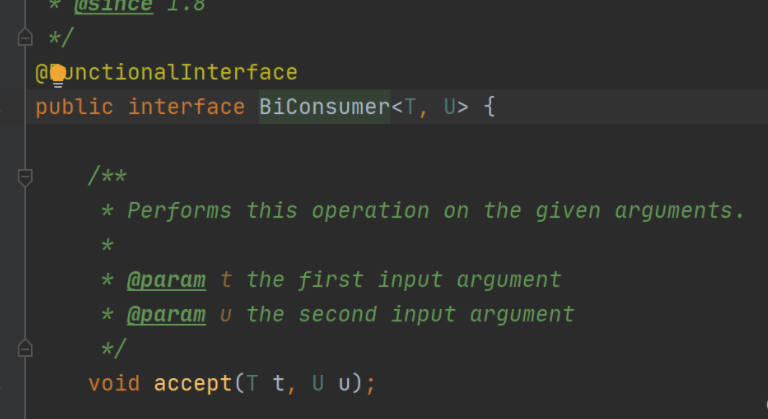您好,登录后才能下订单哦!
这篇文章主要介绍“Java Lambda表达式怎么使用”的相关知识,小编通过实际案例向大家展示操作过程,操作方法简单快捷,实用性强,希望这篇“Java Lambda表达式怎么使用”文章能帮助大家解决问题。
Lambda表达式是Java SE 8中一个重要的新特性。lambda表达式允许你通过表达式来代替功能接口。 lambda表达式就和方法一样,它提供了一个正常的参数列表和一个使用这些参数的主体(body,可以是一个表达式或一个代码
块)。 Lambda 表达式(Lambda expression)可以看作是一个匿名函数,基于数学中的λ演算得名,也可称为闭包(Closure)
基本语法: (parameters) -> expression 或 (parameters) ->{ statements; }
Lambda表达式由三部分组成:
1.paramaters:类似方法中的形参列表,这里的参数是函数式接口里的参数。这里的参数类型可以明确的声明 也可不声明而由JVM隐含的推断。另外当只有一个推断类型时可以省略掉圆括号。
2.->:可理解为“被用于”的意思
3.方法体:可以是表达式也可以代码块,是函数式接口里方法的实现。代码块可返回一个值或者什么都不反 回,这里的代码块块等同于方法的方法体。如果是表达式,也可以返回一个值或者什么都不反回。
// 1. 不需要参数,返回值为 2 ()->2 // 2. 接收一个参数(数字类型),返回其2倍的值 x->2*x // 3. 接受2个参数(数字),并返回他们的和 (x,y) -> x+y // 4. 接收2个int型整数,返回他们的乘积 (int x,int y) -> x * y // 5. 接受一个 string 对象,并在控制台打印,不返回任何值(看起来像是返回void) (String s) -> System.out.print(s)
要了解Lambda表达式,首先需要了解什么是函数式接口,函数式接口定义:一个接口有且只有一个抽象方法 。
注意:
1.如果一个接口只有一个抽象方法,那么该接口就是一个函数式接口
2.如果我们在某个接口上声明了@FunctionalInterface注解,那么编译器就会按照函数式接口的定义来要求该接口,这样如果有两个抽象方法,程序编译就会报错的。所以,从某种意义上来说,只要你保证你的接口 中只有一个抽象方法,你可以不加这个注解。加上就会自动进行检测的。
定义方式:
@FunctionalInterface
interface NoParameterNoReturn {
//注意:只能有一个抽象方法
void test();
}但是这种方式也是可以的:
@FunctionalInterface
interface NoParameterNoReturn {
void test();
default void test2() {
System.out.println("JDK1.8新特性,default默认方法可以有具体的实现");
}
}首先,我们实现准备好几个接口:
@FunctionalInterface
interface NoParameterNoReturn {
//注意:只能有一个抽象方法
void test();
}
//无返回值一个参数
@FunctionalInterface
interface OneParameterNoReturn {
void test(int a);
}
//无返回值多个参数
@FunctionalInterface
interface MoreParameterNoReturn {
void test(int a, int b);
}
//有返回值无参数
@FunctionalInterface
interface NoParameterReturn {
int test();
}
//有返回值一个参数
@FunctionalInterface
interface OneParameterReturn {
int test(int a);
}
//有返回值多参数
@FunctionalInterface
interface MoreParameterReturn {
int test(int a, int b);
}我们在上面提到过,Lambda表达式本质是一个匿名函数,函数的方法是:返回值 方法名 参数列表 方法体。在,Lambda表达式中我们只需要关心:参数列表 方法体。
具体使用见以下示例代码:
@FunctionalInterface
interface NoParameterNoReturn {
//注意:只能有一个抽象方法
void test();
}
//无返回值一个参数
@FunctionalInterface
interface OneParameterNoReturn {
void test(int a);
}
//无返回值多个参数
@FunctionalInterface
interface MoreParameterNoReturn {
void test(int a, int b);
}
//有返回值无参数
@FunctionalInterface
interface NoParameterReturn {
int test();
}
//有返回值一个参数
@FunctionalInterface
interface OneParameterReturn {
int test(int a);
}
//有返回值多参数
@FunctionalInterface
interface MoreParameterReturn {
int test(int a, int b);
}
public class TestDemo2 {
public static void main(String[] args) {
NoParameterNoReturn noParameterNoReturn = () -> {
System.out.println("无参数无返回值");
};
//test方法的主体内容在上述括号内
noParameterNoReturn.test();
OneParameterNoReturn oneParameterNoReturn = (int a) -> {
System.out.println("无参数一个返回值:" + a);
};
oneParameterNoReturn.test(10);
MoreParameterNoReturn moreParameterNoReturn = (int a, int b) -> {
System.out.println("无返回值多个参数:" + a + " " + b);
};
moreParameterNoReturn.test(20, 30);
NoParameterReturn noParameterReturn = () -> {
System.out.println("有返回值无参数!");
return 40;
};
//接收函数的返回值
int ret = noParameterReturn.test();
System.out.println(ret);
OneParameterReturn oneParameterReturn = (int a) -> {
System.out.println("有返回值有参数!");
return a;
};
ret = oneParameterReturn.test(50);
System.out.println(ret);
MoreParameterReturn moreParameterReturn = (int a, int b) -> {
System.out.println("有返回值多个参数!");
return a + b;
};
ret = moreParameterReturn.test(60, 70);
System.out.println(ret);
}
}参数类型可以省略,如果需要省略,每个参数的类型都要省略。
参数的小括号里面只有一个参数,那么小括号可以省略
如果方法体当中只有一句代码,那么大括号可以省略
如果方法体中只有一条语句,其是return语句,那么大括号可以省略,且去掉return关键字。
示例代码:
@FunctionalInterface
interface NoParameterNoReturn {
//注意:只能有一个抽象方法
void test();
}
//无返回值一个参数
@FunctionalInterface
interface OneParameterNoReturn {
void test(int a);
}
//无返回值多个参数
@FunctionalInterface
interface MoreParameterNoReturn {
void test(int a, int b);
}
//有返回值无参数
@FunctionalInterface
interface NoParameterReturn {
int test();
}
//有返回值一个参数
@FunctionalInterface
interface OneParameterReturn {
int test(int a);
}
//有返回值多参数
@FunctionalInterface
interface MoreParameterReturn {
int test(int a, int b);
}
public class TestDemo2 {
public static void main(String[] args) {
//方法参数有多个且方法体中无返回值,则可以省略参数类型
MoreParameterNoReturn moreParameterNoReturn = (a, b) -> {
System.out.println("无返回值多个参数,省略参数类型:" + a + " " + b);
};
moreParameterNoReturn.test(20, 30);
//方法中只有一个参数,那么小括号可以省略
OneParameterNoReturn oneParameterNoReturn = a -> {
System.out.println("方法中只有一个参数,那么小括号可以省略:" + a);
};
oneParameterNoReturn.test(10);
//无参数无返回值,方法体中只有 一行代码的时候,可以去掉方法体的大括号
NoParameterNoReturn noParameterNoReturn = () -> System.out.println("无参数无返回值,方法体中只有 一行代码");
noParameterNoReturn.test();
//方法体中只有一条语句,且是return语句,且无参数
NoParameterReturn noParameterReturn = () -> 40;
int ret = noParameterReturn.test();
System.out.println(ret);
}
}Lambda 表达式中存在变量捕获 ,了解了变量捕获之后,我们才能更好的理解Lambda 表达式的作用域 。Java当中的匿名类中,会存在变量捕获。
下面我们来讲下在Lambda当中也可以进行变量的捕获,具体我们看一下代码:
@FunctionalInterface
interface NoParameterNoReturn {
void test();
}
public class TestDemo2 {
public static void main(String[] args) {
int a = 10;
NoParameterNoReturn noParameterNoReturn = () -> {
/*
注意此处不能够修改a的值,与匿名内部类中相同
a = 99;
*/
System.out.println("捕获变量:" + a);
};
noParameterNoReturn.test();
}
}为了能够让Lambda和Java的集合类集更好的一起使用,集合当中,也新增了部分接口,以便与Lambda表达式对接。

以上方法的作用可自行查看我们发的帮助手册。我们这里会示例一些方法的使用。注意:Collection的forEach()方法是从接口 java.lang.Iterable 拿过来的。
forEach() 方法演示
该方法在接口 Iterable 当中,原型如下:

**forEach()**方法表示:对容器中的每个元素执行action指定的动作
可以看到我们的参数Consumer其实是一个函数式接口:

这个函数式接口中有一个抽象方法accept:

public class TestDemo2 {
public static void main(String[] args) {
ArrayList<String> list = new ArrayList<>();
list.add("Hello");
list.add("bit");
list.add("hello");
list.add("lambda");
list.forEach(new Consumer<String>() {
@Override
public void accept(String s) {
//简单遍历集合中的元素
System.out.println(s);
}
});
}
}输出结果:
Hello bit hello lambda
我们可以修改为如下代码:
public class TestDemo2 {
public static void main(String[] args) {
ArrayList<String> list = new ArrayList<>();
list.add("Hello");
list.add("bit");
list.add("hello");
list.add("lambda");
list.forEach((String s) -> {
System.out.println(s);
});
}
}同时还可以简化代码:
public class TestDemo2 {
public static void main(String[] args) {
ArrayList<String> list = new ArrayList<>();
list.add("Hello");
list.add("bit");
list.add("hello");
list.add("lambda");
list.forEach(s -> System.out.println(s));
}
}sort方法源码:该方法根据c指定的比较规则对容器元素进行排序。
可以看到其参数是Comparator,我们点进去看下:又是一个函数式接口

这个接口中有一个抽象方法叫做compare方法:

使用示例:
public class TestDemo2 {
public static void main(String[] args) {
ArrayList<String> list = new ArrayList<>();
list.add("Hello");
list.add("bit");
list.add("hello");
list.add("lambda");
/*
对list集合中的字符串按照长度进行排序
*/
list.sort(new Comparator<String>() {
@Override
public int compare(String o1, String o2) {
return o1.length() - o2.length();
}
});
/*
输出排序后最终的结果
*/
list.forEach(s -> System.out.println(s));
}
}输出结果为:
bit Hello hello lambda
修改为lambda表达式:
public class TestDemo2 {
public static void main(String[] args) {
ArrayList<String> list = new ArrayList<>();
list.add("Hello");
list.add("bit");
list.add("hello");
list.add("lambda");
/*
对list集合中的字符串按照长度进行排序
*/
list.sort((String o1, String o2) -> {
return o1.length() - o2.length();
}
);
/*
输出排序后最终的结果:
bit
Hello
hello
lambda
*/
list.forEach(s -> System.out.println(s));
}
}此时还可以对代码进行简化:
public class TestDemo2 {
public static void main(String[] args) {
ArrayList<String> list = new ArrayList<>();
list.add("Hello");
list.add("bit");
list.add("hello");
list.add("lambda");
/*
对list集合中的字符串按照长度进行排序
*/
list.sort((o1, o2) ->
o1.length() - o2.length()
);
/*
输出排序后最终的结果:
bit
Hello
hello
lambda
*/
list.forEach(s -> System.out.println(s));
}
}HashMap 的 forEach()方法:

这个函数式接口中有一个抽象方法叫做accept方法:

代码示例:
public class TestDemo2 {
public static void main(String[] args) {
HashMap<Integer, String> map = new HashMap<>();
map.put(1, "hello");
map.put(2, "bit");
map.put(3, "hello");
map.put(4, "lambda");
map.forEach(new BiConsumer<Integer, String>() {
@Override
public void accept(Integer integer, String s) {
System.out.println(integer + " " + s);
}
});
}
}输出结果:
1 hello
2 bit
3 hello
4 lambda
使用lambda表达式后的代码:
public class TestDemo2 {
public static void main(String[] args) {
HashMap<Integer, String> map = new HashMap<>();
map.put(1, "hello");
map.put(2, "bit");
map.put(3, "hello");
map.put(4, "lambda");
map.forEach((Integer integer, String s) -> {
System.out.println(integer + " " + s);
}
);
}
}还可以对代码继续简化:
public class TestDemo2 {
public static void main(String[] args) {
HashMap<Integer, String> map = new HashMap<>();
map.put(1, "hello");
map.put(2, "bit");
map.put(3, "hello");
map.put(4, "lambda");
map.forEach((integer, s) ->
System.out.println(integer + " " + s)
);
}
}关于“Java Lambda表达式怎么使用”的内容就介绍到这里了,感谢大家的阅读。如果想了解更多行业相关的知识,可以关注亿速云行业资讯频道,小编每天都会为大家更新不同的知识点。
免责声明:本站发布的内容(图片、视频和文字)以原创、转载和分享为主,文章观点不代表本网站立场,如果涉及侵权请联系站长邮箱:is@yisu.com进行举报,并提供相关证据,一经查实,将立刻删除涉嫌侵权内容。